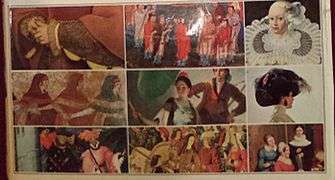Portrait of Margarete Brömsen
|
Portrait of Margarete Brömsen | |
| Artist | Michael Conrad Hirt |
|---|---|
| Year | 1642 |
| Dimensions | 124.5 cm × 91 cm (49.0 in × 36 in) |
| Location | St. Anne's Museum, Lübeck |
| Accession | 166 |
Portrait of Margarete Brömsen is a painting by the German Baroque painter Michael Conrad Hirt, painted in 1642 and now in St. Anne's Museum.[1] It is considered a wedding portrait, but a pendant of her husband, Diedrich von Brömsen, is unknown.
Painting
This painting is inscribed with MARGRETA.BRÖMSEN NATA . A:1626.30 NOVEMB NUPTA. A:1641.29.NOVEMB: MORTUA. A:1642.16.APRIL, which reports Margarete Brömsen's birth date (30 November 1626), the marriage date (29 November 1641), and the death date (16 April 1642).[2] She is wearing a lace cap and a wide lace collar over a white dress edged with gold trim with a gold chain. In her right hand she holds a carnation and in her gloved left hand she holds another glove. Margarete Brömsen was the wealthy daughter of the Lübeck mayor Anton Kohler. The visible amount of gold in her dress shows an ostentatious display that may be the result of the 9 October 1641 confirmation of nobility rights for the families of Warendorp, Wickede, Brömsen, Luneburg, Kerkring, and Stiten by Emperor Ferdinand III. The privileges are referred to as the Zirkelgesellschaft (Circle company).
This portrait was selected by Yvonne Deslandres for her book 20,000 Years of Fashion to illustrate the backward fashion of German provincial weddings, and the unusual cap was featured on the cover.[3] Certainly the headdress is unusual and in the same book similar formal dress of important women of the same region show a fashion of wearing the hair without any covering, and wearing dresses that accentuate the waist. Considering it was only 5 months after her wedding that Margarete Brömsen died, she was possibly painted during her pregnancy and probably died in childbirth. Possibly the painting is a posthumous portrait, which would explain why there is no pendant.
Legacy
In the 1990s this painting enjoyed some notoriety as it was considered to be the wedding dress that formed the basis for the costume design by Eiko Ishioka for the role of Lucy Westenra portrayed by Sadie Frost in Bram Stoker's Dracula.
-

Cover of 20,000 Years of Fashion with a detail of this portrait upper right.
References
- ↑ record 00044443 in the Marburg Bildindex
- ↑ Portret van Margarete Brömsen, 1642 gedateerd in the RKD
- ↑ 20,000 Years of Fashion, page 274, illustration 647
.jpeg)